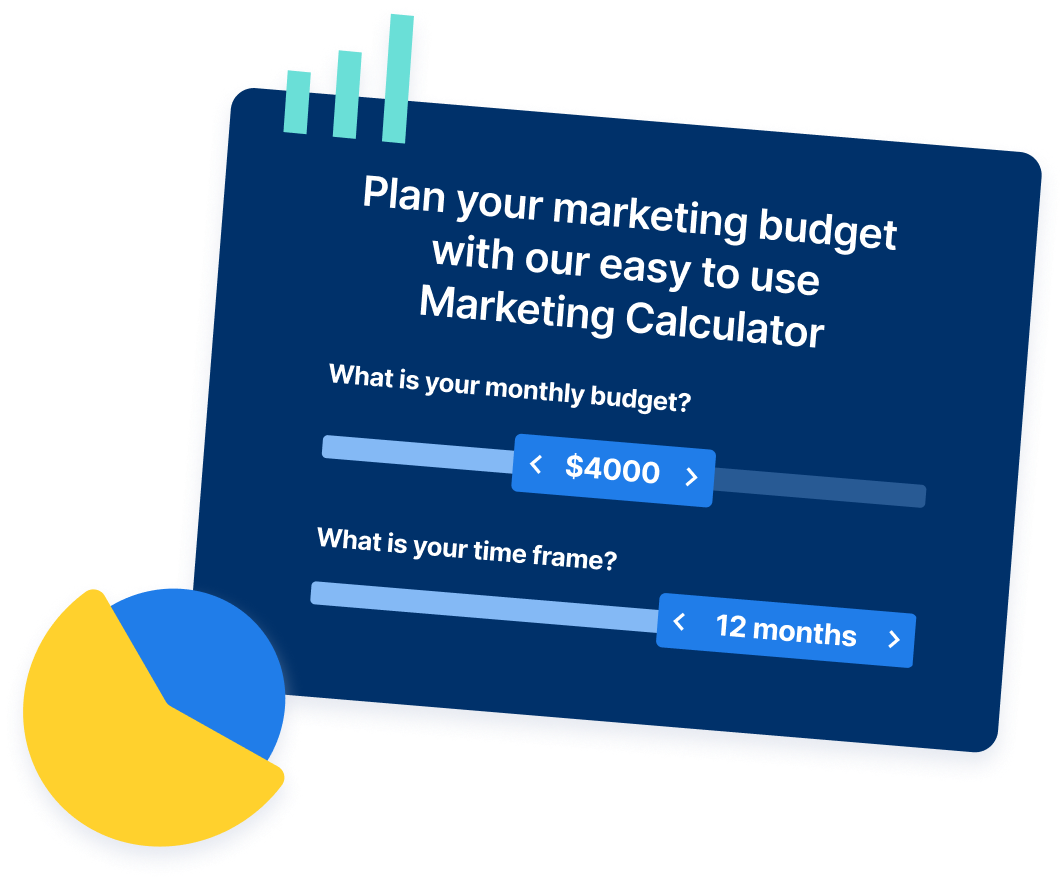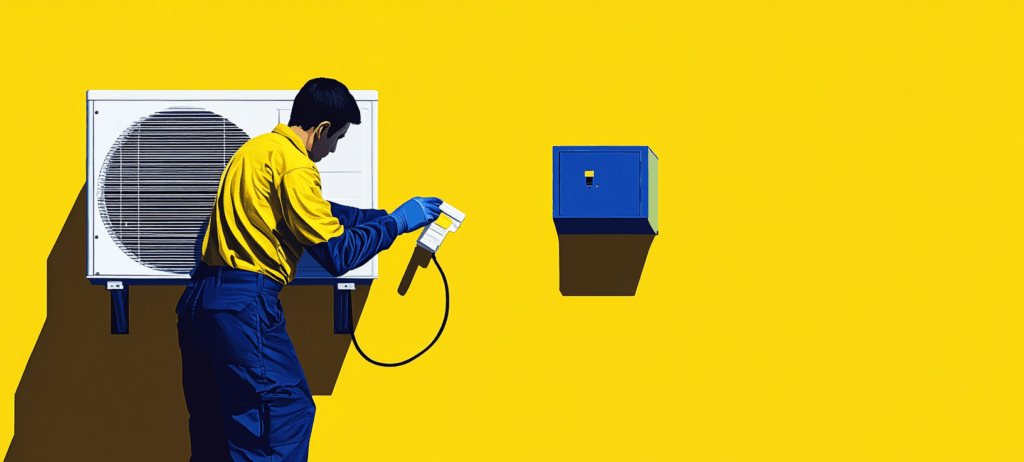- Home
- Blog
- Home Services
- 2025 HVAC Marketing Benchmarks: How Does Your Business Stack Up? (+ Real Numbers & Expert Insights)
2025 HVAC Marketing Benchmarks: How Does Your Business Stack Up? (+ Real Numbers & Expert Insights)
-
 Published: Aug 20, 2025
Published: Aug 20, 2025
-
 10 min. read
10 min. read
-
Summarize in ChatGPT
-
 Albert Dandy Velasquez
Albert Dandy Velasquez Content Specialist
Content Specialist
- Albert Dandy Velasquez blends SEO strategy with compelling storytelling to help businesses boost their visibility and revenue online. With a B.A. in English and certifications from HubSpot, Semrush, and Google Analytics, he has written and optimized hundreds of articles on organic SEO, content strategy, and user experience. He regularly contributes to the WebFX blog and SEO.com, creating content that helps readers turn marketing goals into measurable results. When he’s off the clock, he’s usually exploring new neighborhoods on two wheels, filming travel content, or chasing golden hour with a coffee in hand.
Table of Contents
- What are HVAC marketing benchmarks (and why do they matter)?
- Must-track HVAC marketing benchmarks for maximum ROI
- HVAC marketing benchmarks snapshot (fast facts)
- 1. Cost & ROI benchmarks
- 2. Sales cycle & growth indicators
- 3. Paid advertising & CPC benchmarks
- 4. SEO & keyword opportunity benchmarks
- 5. Competitive landscape insights
- 6. Content & publishing benchmarks
- FAQs about HVAC marketing benchmarks
- Data sources & methodology
-
What are HVAC marketing benchmarks?
HVAC marketing benchmarks are industry-specific performance metrics that help evaluate how effectively your marketing attracts, converts, and retains customers—providing clear insights into what drives leads, what’s underperforming, and where you can maximize ROI. -
What is a healthy cost per lead for HVAC companies?
The industry average cost per lead (CPL) is $153, while customer acquisition cost (CAC) ranges from $75–$250 depending on the channel, and a healthy customer lifetime value to CAC ratio should be 3:1 or higher to ensure profitable marketing investments. -
How much are HVAC businesses spending on paid advertising?
The average cost per click for HVAC keywords in 2024 is $29.03 (projected to rise to $32.77 in 2025), with premium commercial keywords costing $5+ per click and seasonal spikes occurring during summer cooling and winter heating periods. -
Which keywords drive the most HVAC traffic?
High-volume keywords include “hvac” (247,000 monthly searches), “furnace repair” (64,000 searches), and “hvac near me” (63,000 searches), with local intent keywords like “near me” terms showing 15–20% higher CPC but delivering stronger conversion rates due to proximity intent. -
How often should HVAC companies publish content?
Enterprise brands publish 10–20 new pages weekly with 100,000+ indexed pages, regional players add 5–10 pages weekly, and local businesses should aim for 1–2 pages weekly—with technical guides (30%) and local service pages (25%) being the top-performing content types.
TL;DR: What are HVAC marketing benchmarks?
HVAC marketing benchmarks are key performance metrics that help you measure how well your marketing attracts leads, converts customers, and generates revenue compared to industry standards.
Here’s what strong HVAC marketing performance looks like:
- Cost per lead (CPL): $153 (average)
- Conversion rate: 3.10% (industry standard)
- Customer lifetime value (CLV): $15,340
- Cost per click (CPC): $29.03
- Net profit margin: 8%
Tracking these benchmarks helps you identify underperforming campaigns, improve ROI, and compete more effectively in your market. Use them to set smarter goals, refine strategy, and make better budget decisions.
Industry benchmarks act like X-ray vision for your marketing. They expose what’s generating real results, what’s bleeding your budget dry, and where you’re sitting on revenue you haven’t tapped yet.
Marketing leaks are real (and expensive). But here’s the good news: you don’t need to track everything to seal the gaps. You just need to track what actually books more jobs. Here’s where to start.
What are HVAC marketing benchmarks (and why do they matter)?
HVAC marketing benchmarks are industry-specific performance metrics used to evaluate how effectively your marketing efforts attract, convert, and retain customers. They give you a clear picture of how your marketing measures up to your competitors and lay bare what’s driving leads, what’s falling flat, and where you have the biggest opportunity to maximize your return on investment (ROI).
Let’s be real, nothing kills your peace of mind faster than watching leads dry up while your ad spend keeps climbing. If your HVAC marketing feels like a guessing game, it’s time to pivot your focus. Marketing benchmarks help you get your strategy back on track with real numbers, real goals, and real returns.
Without clear HVAC industry benchmarks, you’re just spending and hoping for the best. Here’s how they can help your business:
- Set realistic goals based on industry performance, not gut feelings
- Spot weak points in your strategy before you set your budget on fire
- Prove ROI to stakeholders with data-backed insights
- Stay competitive in an increasingly oversaturated HVAC market
Must-track HVAC marketing benchmarks for maximum ROI
Low-quality leads. Sky-high ad costs. Zero visibility into what’s working. If that sounds familiar, your HVAC marketing isn’t broken. It’s just not benchmarked.
But how do we flip the script? Tracking these benchmarks separates profitable businesses from the ones that stay stuck:
- HVAC marketing benchmarks summary
- Cost & ROI benchmarks
- Sales cycle & growth indicators
- Paid advertising & CPC benchmarks
- SEO & keyword opportunity benchmarks
- Competitive landscape insights
- Content & publishing benchmarks
HVAC marketing benchmarks snapshot (fast facts)
Before diving deep into the numbers, take a moment to see the big picture. This HVAC marketing benchmark snapshot gives you a clear view of how the industry is performing right now. If you’re trying to make sense of your HVAC marketing metrics or just want to know how your brand compares, these quick-hit stats make it easy to benchmark your HVAC marketing performance at a glance.
| Category | Metric | Industry benchmark |
| Cost efficiency | Cost per lead (CPL) | $153 |
| ROI | Customer lifetime value (CLV) | $15,340 |
| Profitability | Net profit margin | 8% |
| Performance | Conversion rate | 3.10% |
| Ad spend | CPC (2024 average) | $29.03 |
| Growth outlook | Industry growth rate (2024) | 5.60% |
1. Cost & ROI benchmarks
When it comes to HVAC marketing performance, it’s easy to get lost in surface-level metrics. But the numbers that matter most are the ones that track real return. How much it costs you to earn a lead, how much value that customer brings, and whether the math adds up in the long run.
These foundational HVAC industry benchmarks not only keep your campaigns accountable but also spotlight where your growth could be more sustainable, profitable, and strategic.
| Metric | Benchmark | What it measures |
| Cost per lead (CPL) | $153 (industry average) | Efficiency of lead generation |
| Customer acquisition cost (CAC) | $75–$250 (various channels) | Total cost to convert a new customer |
| Customer lifetime value (CLV) | $15,340 (B2B/B2C) | Total long-term value of a customer |
| CLV:CAC ratio | 3:1 or higher | Profitability of marketing investments |
💡 Why these metrics drive (or drain) your profit
If your cost to win a customer eats most of the revenue that customer brings in, you’re not building a business, but you’re just buying work. Tracking these HVAC marketing benchmarks shows whether you’re fostering profitability or just spinning your wheels. Knowing your true ROI helps you double down on what’s working and cut what’s draining your bottom line.
🔧 Boost your HVAC ROI with these smart moves:
Optimize your CPL
Refine targeting by using geo-modifiers, audience segmentation, and exclusion lists to avoid low-intent clicks.
Improve CLV
Introduce seasonal maintenance packages, loyalty perks, or upsell opportunities (e.g., duct cleaning + HVAC checkup).
Lower CAC
Automate lead nurturing with email/SMS to reduce the need for sales rep outreach per lead.
Track ROI in real time
Use tools like RevenueCloudFX to connect leads back to source campaigns.
Bundle services
Increase average job size by packaging install + service + warranty.
2. Sales cycle & growth indicators
Benchmarking HVAC marketing is all about momentum. How quickly are leads turning into customers? Is your market expanding faster than your reach? These benchmarks let you compare your internal pipeline speed with external HVAC industry growth, helping you scale and stay competitive at the same time.
| Metric | Benchmark | What it measures |
| Industry growth rate (2024) | 5.60% (consistent B2B/B2C) | Annual growth of the HVAC industry |
| Projected CAGR (2024–2031) | 7.10% (projected growth) | Long-term growth potential |
| Gross margin average | 35% (consistent B2B/B2C) | Profitability before costs |
| Net margin average | 8% (after all costs) | Final profit after all expenses |
| Marketing spend as % of revenue | 7% (annual allocation) | How much of the revenue is reinvested into marketing |
| Lead-to-customer conversion rate | 3.10% (industry standard B2B/B2C) | Sales effectiveness |
| Missed call rate | 27% (operational inefficiency) | Lost leads due to unanswered calls |
💡 Why speed and scale matter more than ever
HVAC isn’t just seasonal, but it’s also competitive and timing-sensitive. The faster you move leads through your pipeline, the more jobs you close before competitors even respond. These HVAC marketing benchmarks help you spot friction in your sales cycle and ride industry tailwinds, not miss them.
🔧 Close deals faster with these proven approaches:
Speed up lead-to-close
Respond to inbound leads within 5 minutes to increase conversion by up to 400%.
Set up missed call automation
Use tools like CallRail to trigger texts after missed calls.
Offer flexible financing
Remove pricing friction by promoting low-interest or deferred payment options.
Use CRM lifecycle tagging
Monitor where leads stall in the funnel and automate follow-ups.
Train sales reps on consultative selling
Helps close high-ticket HVAC jobs vs. basic repairs.
3. Paid advertising & CPC benchmarks
HVAC paid advertising can generate strong returns, but only if you’re tracking the right HVAC marketing performance metrics. With cost per click (CPC) rising year over year, especially during peak seasons, understanding real-world ad costs gives you an edge when setting bids and building pay-per-click (PPC) strategies that don’t bleed your budget dry.
| Metric | Benchmark | What it measures |
| CPC average (2025) | $32.77 | Estimated HVAC CPC next year |
| CPC average (2024) | $29.03 | Current average CPC benchmark |
| CPC average (2023) | $26.88 | Previous year’s CPC benchmark |
| CPC average (2022) | $26.22 | Historical baseline for CPC |
| Paid search CPC range | $0.15–$8.00 | General keyword CPC spread |
| Average CPC for most keywords | $1.50–$2.00 | Typical CPC for mid-funnel searches |
| Premium CPC (Commercial keywords) | $5.00+ | High-intent commercial terms |
⚠️ Seasonality alert: HVAC CPCs spike in summer (cooling) and winter (heating). Plan aggressive bids and higher budgets during these peaks.
💡 Why smart bidding beats big budgets
Every click costs your business, and those clicks are getting more expensive by the day. Knowing your average CPC and how it trends by season helps prevent waste and ensures your PPC budget goes toward high-intent, high-converting traffic. These HVAC industry benchmarks enable you to spend smarter and not just spend less.
🔧 Stretch your ad spend with these smarter PPC plays:
Target mid-funnel intent terms
Phrases like “HVAC installation near me” have lower CPCs and higher conversion than top-funnel terms like “air conditioning.”
Geo-target aggressively
Limit PPC to service areas with high profit margins or fast technician availability.
Use call-only campaigns in emergencies
These perform well during seasonal spikes when homeowners want to speak now.
Schedule ads during peak urgency hours
Early morning and evening (pre/post work) often convert better.
Test RSA
Let Google optimize your headlines and descriptions for performance with responsive search ads (RSA) to reach users across a broader spectrum.
4. SEO & keyword opportunity benchmarks
Organic visibility is a long game, and these HVAC marketing benchmarks help you play it savvy. Tapping into keyword intent and capitalizing on local search trends can set your business apart from national players who overlook local relevance.
Top volume keywords
| Keyword | Metrics | Intent |
| hvac |
|
|
| furnace repair |
|
|
| hvac near me |
|
|
| ac repair near me |
|
|
| air conditioner |
|
|
| air conditioning repair |
|
|
High-value commercial keywords
| Keyword | Monthly volume | Difficulty | Intent profile |
| residential hvac | 2,400 | 78 | Commercial |
| commercial hvac | 14,000 | 41 | Commercial |
| ductwork repair | 1,300 | 0 | Service-Focused |
| furnace installation | 16,000 | 4 | Commercial + Transactional |
| hvac services | 24,000 | 49 | Commercial |
| hvac meaning | 47,000 | 59 | Informational (High CPC) |
| heating repair | 16,000 | 45 | Commercial + Transactional |
| carrier | 61,000 | 66 | Branded |
Local search patterns
| Local intent keywords | Monthly searches | CPC |
| hvac near me | 63,000 | $0.15 |
| ac repair near me | 62,000 | $0.20 |
| furnace repair near me | 48,000 | $0.25 |
📊 Local insights:
- 15–20% higher CPC for “near me” terms
- 85%+ of results feature Google local pack
- Higher conversion rates due to intent proximity
💡 Why search visibility = lead velocity
People search for HVAC help the moment something breaks, and if you’re not on Page 1, you’re basically invisible. These HVAC marketing benchmarks help you understand what your ideal customers are typing into Google and how to show up exactly when they need you most.
🔧 Win more organic traffic and local leads with these tactics:
Build city + service pages
Rank for “[service] in [city]” long-tail variations like “furnace repair Sacramento.”
Prioritize commercial-intent keywords
“HVAC installation,” “ductwork repair,” and “emergency AC repair” convert better than “what is HVAC.”
Create FAQ content targeting voice search
Answer questions like “Why is my AC blowing warm air?” using schema markup.
Improve local SEO
Optimize your Google Business Profile with service types, reviews, photos, and service area coverage.
Use internal linking to push high-priority pages
Internally link from blog posts and service pages back to your core revenue drivers.
5. Competitive landscape insights
You don’t need to outspend industry giants; you just need to outsmart them. The top HVAC brands dominate national awareness, but most leave local markets wide open. These HVAC industry insights show where smaller businesses can win big by being nimble, targeted, and locally optimized.
Major HVAC brand performance (December 2024)
| Domain | Organic Performance | Paid Performance |
| trane.com |
|
|
| carrier.com |
|
|
| carrierenterprise.com |
|
|
📊 Key insights:
Organic dominance: Major brands rely heavily on organic search (99%+ of traffic)
Minimal paid spend: Surprisingly low paid search investment by major players
Content volume: 100K+ ranking keywords indicate massive content strategies
Market opportunity: Low paid search competition suggests an opportunity for smaller players
💡 Why small brands win when giants sleep
National HVAC brands may be in the saddle for awareness, but they can also leave conversion-rich local search untapped. These insights show how you can outmaneuver them by getting hyper-specific with targeting and content. Local visibility is that one trick up your sleeve; use it to turn their blind spots into your booked jobs.
🔧 Exploit gaps left by bigger brands with these recommendations:
Outpace them locally with PPC
National brands underinvest in geo-targeted paid search. Bid on “[brand name] + city” to win comparison shoppers.
Capture “vs” and “best” queries
Write content comparing HVAC brands or explaining why your business beats national chains on service and speed.
Own niche categories
Be in charge of smaller categories like “mini-split install,” “thermostat replacement,” or “ductless systems.”
Publish customer testimonials with location tags
Helps build E-E-A-T (experience, expertise, authority, trust) and convert fence-sitters.
Target competitor-intent audiences
Use custom segments in Google Ads to reach users who’ve searched for HVAC brand names or browsed related websites.
6. Content & publishing benchmarks
Consistency is the secret sauce in HVAC marketing. Publishing steady, service-focused content builds long-term authority, accelerates keyword coverage, and earns trust with both Google and customers. High-performing brands treat publishing like clockwork, pushing out fresh, optimized content every week to capture seasonal demand and long-tail queries.
These HVAC marketing benchmarks reveal the volume, type, and frequency that set top performers apart.
Publishing velocity
| Business type | Indexed pages | New pages/week |
| Enterprise brands | 100K+ | 10–20 |
| Regional players | 5K-15K | 5–10 |
| Local businesses | 50-500 | 1–2 |
Top-performing content types
| Content type | Share of top content |
| Technical guides | 30% |
| Local service pages | 25% |
| Product comparisons | 20% |
| Troubleshooting content | 15% |
| Installation guides | 10% |
💡 Why content quantity & quality affect growth
Google rewards relevance, not just reputation. You don’t need to outpublish national brands, but you do need to outsmart them with locally optimized, consistent content that builds trust. One high-quality service page can bring in dozens of leads every month. Momentum builds, one post at a time.
🔧 Build content that converts and ranks with these strategies:
Stick to a content schedule
Even one SEO-optimized page per week can dramatically grow traffic over time.
Turn service FAQs into blog posts
Each question your techs get can be a blog that ranks and educates customers.
Create internal linking hubs
Organize content around pillar pages like “HVAC repair” and link out to subtopics (e.g., AC not blowing cold, thermostat troubleshooting).
Repurpose reviews and service calls into case studies
Build trust and showcase results (bonus if geo-tagged).
Add video walkthroughs
Short “how it works” or “before & after” clips increase engagement and may show in SERP features.
FAQs about HVAC marketing benchmarks
What are HVAC marketing benchmarks?
HVAC marketing benchmarks are measurable performance standards that help you track how well your marketing is generating leads, converting customers, and driving revenue. These HVAC marketing metrics serve as a comparison point for gauging what’s working and what needs improvement.
Must-track HVAC industry benchmarks include:
- Cost per lead (CPL): $153 average
- Conversion rate: 3.10% industry standard
- Customer lifetime value (CLV): $15,340
- Cost per click (CPC): $29.03 average in 2024
- Net profit margin: 8%
By benchmarking HVAC marketing performance, you can optimize campaigns, allocate budget more effectively, and stay competitive in your market.
What is considered good HVAC marketing performance?
While “good” results may vary by region or business model, here are some common performance benchmarks HVAC businesses should aim for:
- Landing page conversion rates: 10% or higher
- Cost per lead (CPL): Between $25–$75 for highly efficient campaigns
- Return on ad spend (ROAS): 2–5x return is considered strong
- Customer retention: High retention via maintenance plan renewals
- Engagement: Above-average click-through rates (CTRs) (>3%) and low bounce rates (<50%)
If your numbers hit or exceed these ranges, your HVAC marketing strategy is likely delivering solid ROI.
What is considered bad HVAC marketing performance?
Recognizing poor performance early helps reduce wasted spend and missed opportunities. Here are red flags to watch for:
- High CPLs (above $150): Often caused by poor targeting or ad quality
- Low conversion rates (<3%): Indicates ineffective landing pages or messaging
- High bounce rate (>70%): Suggests technical issues or mismatched content
- Unqualified leads: Getting calls or form fills that don’t convert
- Low engagement: Poor CTRs on ads and little interaction on posts or ads
If you’re consistently seeing these metrics, it’s time to audit your campaigns or consult with a digital marketing partner.
How often should I review HVAC marketing benchmarks?
Most HVAC businesses should review benchmarks quarterly, especially to account for seasonal fluctuations in demand (summer AC, winter heating). However, if you’re running PPC campaigns or experiencing performance dips, a monthly review can help you spot issues early and pivot faster.
Tracking your HVAC marketing metrics regularly ensures you’re making data-informed decisions instead of relying on gut instinct.
How do I know if my HVAC marketing performance is strong?
Use benchmarking HVAC marketing performance as your starting point. You can consider your performance strong if:
- Your CPL is lower than $153
- Your CLV is above $15,000
- Your ads generate a 2x–5x ROAS
- Your leads convert above 3%
- Your website maintains a bounce rate below 50%
You can also set SMART goals (Specific, Measurable, Achievable, Relevant, Time-bound) for each channel, like aiming for 100 leads/month through Google Ads or improving lead-to-close rate by 10% over a quarter.
Can small HVAC businesses compete with national brands?
Yes, and in many cases, small HVAC contractors outperform national brands locally. Big brands often dominate organic search nationally but invest very little in hyperlocal paid search or service-specific SEO. That leaves local businesses with opportunities to win in:
- Local SEO (Google Business Profile, local pack)
- Service page targeting (e.g., “ductwork repair in Fresno”)
- Geo-targeted PPC campaigns
- Faster lead response and more personalized service
With a smart digital strategy and clear HVAC industry benchmarks, smaller businesses can consistently win more jobs in their zip codes.
How does seasonality affect HVAC marketing performance?
Seasonality plays a huge role in HVAC marketing metrics like CPC, CPL, and conversion rates. For example:
- CPCs spike in summer (cooling services) and winter (heating services)
- Conversion rates climb when urgency increases (like during a heatwave)
- Ad budgets often need boosting in Q2 and Q4 to stay competitive
Benchmarking HVAC marketing performance by season helps you prepare ahead of time, adjust your ad bidding strategy, and invest in content that aligns with seasonal needs (e.g., furnace tune-ups in fall).
How can HVAC companies improve their CPL?
To lower your cost per lead without sacrificing lead quality:Improve local SEO to attract organic traffic
- Refine your PPC targeting with better keywords and geo filters
- Use call tracking to identify your highest-converting sources
- Optimize landing pages for speed, clarity, and urgency
- Retarget visitors with display or social ads to re-engage warm leads
- Incentivize action with limited-time offers or free consultations
Also, make sure your techs are trained to close the leads your marketing brings in. Marketing gets the phone ringing, but ops keeps it profitable.
Keep your crews busy with the right HVAC marketing partner
The key to HVAC marketing success isn’t just launching campaigns; it’s benchmarking performance, optimizing strategy, and doubling down on what actually delivers. Leverage these HVAC marketing benchmarks to identify gaps, improve decision-making, earn more jobs with HVAC SEO, and get more value from your marketing spend.
But keep in mind that while benchmarking HVAC marketing is a critical advantage, it’s only the first step. Turning those insights into action is where the real ROI begins.
At WebFX, we help HVAC companies turn their data into tangible results. With more than 29 years of HVAC marketing experience and over 343 subject-matter experts, we’ve already generated 299,475 qualified leads and $21 million in revenue for businesses like yours.
Here’s what you get when you partner with us:
Transparent, ROI-driven strategies tailored for HVAC
Industry-specific expertise backed by real results
A dedicated account manager who gets your business
Real-time results tracking with RevenueCloudFX
You’re not running your HVAC business on guesswork, so why market it that way? Partnering with a proven HVAC marketing agency can mean the difference between a packed schedule and a slow season.
It’s time to keep your crews booked solid year-round. Get your free proposal or call 888-601-5359 to connect with an HVAC marketing strategist today!
Data sources & methodology
This report blends real-world HVAC marketing performance data with competitive insights from trusted third-party research tools and internal benchmarks. Our goal is to provide HVAC professionals with accurate, actionable metrics that reflect today’s search space and customer behavior.
Here’s how we built this benchmark report:
Proprietary data: Internal industry benchmarks and performance metrics
Ahrefs data: Keyword research, traffic analysis, competitive intelligence (December 2024)
Analysis period: Current data with 12-month historical context
Geographic focus: United States market
Sample size: 50+ core HVAC keywords, 3 major competitor analyses
Report compiled: July 31, 2025
-
 Albert Dandy Velasquez blends SEO strategy with compelling storytelling to help businesses boost their visibility and revenue online. With a B.A. in English and certifications from HubSpot, Semrush, and Google Analytics, he has written and optimized hundreds of articles on organic SEO, content strategy, and user experience. He regularly contributes to the WebFX blog and SEO.com, creating content that helps readers turn marketing goals into measurable results. When he’s off the clock, he’s usually exploring new neighborhoods on two wheels, filming travel content, or chasing golden hour with a coffee in hand.
Albert Dandy Velasquez blends SEO strategy with compelling storytelling to help businesses boost their visibility and revenue online. With a B.A. in English and certifications from HubSpot, Semrush, and Google Analytics, he has written and optimized hundreds of articles on organic SEO, content strategy, and user experience. He regularly contributes to the WebFX blog and SEO.com, creating content that helps readers turn marketing goals into measurable results. When he’s off the clock, he’s usually exploring new neighborhoods on two wheels, filming travel content, or chasing golden hour with a coffee in hand. -

WebFX is a full-service marketing agency with 1,100+ client reviews and a 4.9-star rating on Clutch! Find out how our expert team and revenue-accelerating tech can drive results for you! Learn more
Try our free Marketing Calculator
Craft a tailored online marketing strategy! Utilize our free Internet marketing calculator for a custom plan based on your location, reach, timeframe, and budget.
Plan Your Marketing Budget
Table of Contents
- What are HVAC marketing benchmarks (and why do they matter)?
- Must-track HVAC marketing benchmarks for maximum ROI
- HVAC marketing benchmarks snapshot (fast facts)
- 1. Cost & ROI benchmarks
- 2. Sales cycle & growth indicators
- 3. Paid advertising & CPC benchmarks
- 4. SEO & keyword opportunity benchmarks
- 5. Competitive landscape insights
- 6. Content & publishing benchmarks
- FAQs about HVAC marketing benchmarks
- Data sources & methodology

Outrank Local Competitors This Season
See how home service pros like you are dominating local Google results and booking more jobs.

Proven Marketing Strategies
Try our free Marketing Calculator
Craft a tailored online marketing strategy! Utilize our free Internet marketing calculator for a custom plan based on your location, reach, timeframe, and budget.
Plan Your Marketing Budget




